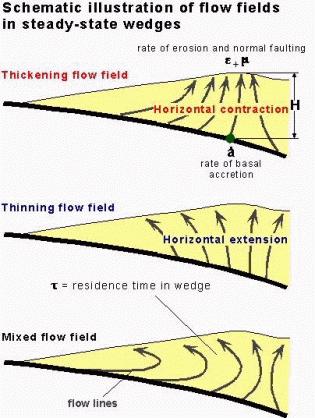
ACCRETIONARY PRISMS OR WEDGES
Accretionary wedges are accumulations of sediment scraped off from
the downgoing (underthrust) slab during subduction. They are landward of
oceanic trenches formed by the subduction process. Subduction may be of
'oceanic lithosphere' or beneath a continent (continental arcs) or beneath
other 'oceanic lithosphere' (island arcs). Critical
Wedge Taper in Accretionary Prisms (see this in this collection): The
thickness of the wedge depends on the amount of scraped sediment
available. The critical taper of the wedge is based on strength of the
wedge material and on the basal shear strength of the edge. Proper
accommodation of the taper involves thrusting, slumping, and normal
faulting. Offscraping and underplating of the sediment beneath the
accretionary prism is accomplished by thrust faulting. The wedge is
underlain by a detachment fault on the top of the descending slab. This
fault ramps to progressively shallower levels toward the trench. See ramps
and flats. Subduction
produces asymmetric foreland fold & thrust belt and an accretionary
prism and progressive continental collision will produce symmetric
foreland fold and thrust belts with opposite vergence. Volcanic arc rocks
formed by subduction are complexly deformed during the eventual collision. |